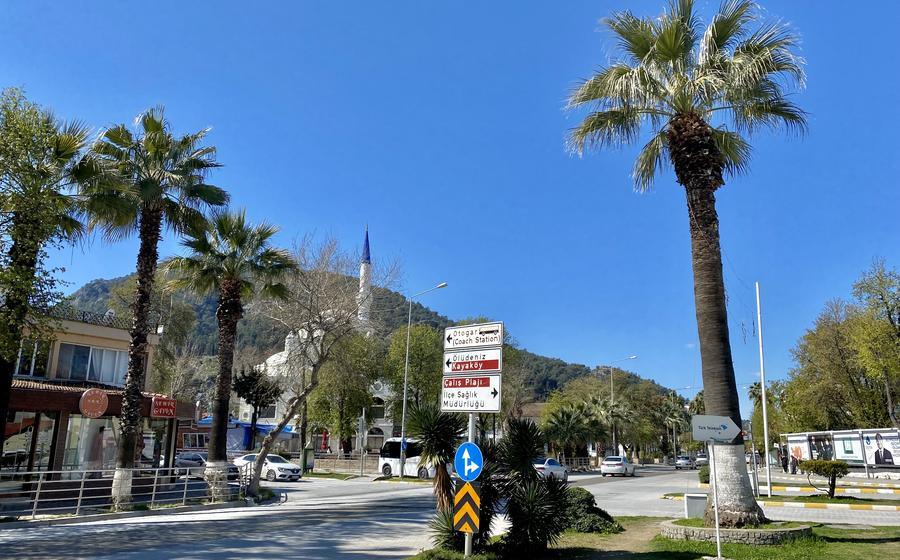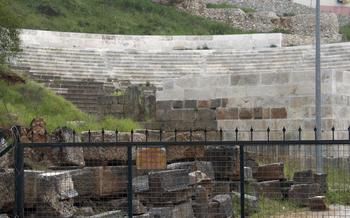
Marmaris Amphitheater
- Marmaris Amphitheater: An Ode to Ancient History
- Step Back in Time: The History of the Amphitheater
- Immerse Yourself in the Architecture
- Spectacles and Entertainment
- A Walk Through the Amphitheater
- The Amphitheater's Role in Modern Times
- Marmaris Amphitheater Museum
- Transportation and Accessibility
- Best Time to Visit
- Nearby Attractions
- Capture the Moment
- Unleash Your Inner Historian
- Dress for the Occasion
- Respect the History
- Insider Tip: Hidden Gems
Marmaris Amphitheater: An Ode to Ancient History
A Journey Through Time: Journey back to the era of gladiators and emperors as you step into the Marmaris Amphitheater, a testament to the enduring legacy of the Roman Empire. Located in the heart of Marmaris, this impressive structure stands as a symbol of the region's rich history and cultural heritage. Its convenient location within the city center makes it easily accessible for visitors to explore and appreciate its architectural grandeur.
Architectural Marvel: The Marmaris Amphitheater is a marvel of ancient engineering, boasting intricate architectural features and a captivating design. Its elliptical shape and tiered seating arrangement, characteristic of Roman amphitheaters, provide an awe-inspiring view from any angle. Admire the well-preserved stone arches and columns that frame the stage, adding to the amphitheater's majestic presence.
A Stage for Spectacles: Throughout history, the Marmaris Amphitheater has played host to a variety of events and performances that captivated audiences. In ancient times, gladiatorial contests, animal hunts, and theatrical performances filled the air with excitement and wonder. Today, the amphitheater continues to serve as a venue for cultural events, concerts, and festivals, offering visitors a glimpse into the vibrant entertainment of the past.
Step Back in Time: The History of the Amphitheater
The Marmaris Amphitheater, a testament to the grandeur of the Roman Empire, was constructed during the reign of Emperor Claudius in the 1st century AD. Its construction was likely funded by wealthy patrons or the local government, seeking to provide entertainment and cultural events for the citizens of Marmaris.
During the Roman period, amphitheaters played a significant role in the social and cultural life of the empire. They served as venues for a variety of events, including gladiatorial contests, animal hunts, theatrical performances, and public executions. The Marmaris Amphitheater, with its impressive size and elaborate design, would have been a prominent landmark in the city, drawing large crowds for these spectacles.
Amphitheaters were carefully designed to accommodate the needs of both the audience and the performers. The seating arrangement consisted of concentric rows of stone benches, rising steeply from the arena floor. The lower rows were reserved for VIPs and officials, while the upper rows were occupied by the general public. The seating capacity of the Marmaris Amphitheater is estimated to have been around 15,000 spectators, making it one of the largest amphitheaters in the region.
Over the centuries, the amphitheater underwent various modifications and renovations. During the Byzantine period, it was converted into a fortress, with additional fortifications and towers being constructed. Later, during the Ottoman period, the amphitheater fell into disuse and was gradually covered by soil and vegetation.
In the 20th century, archaeological excavations were conducted at the site, revealing the amphitheater's well-preserved remains. The restoration work that followed brought the amphitheater back to life, allowing visitors to appreciate its architectural grandeur and historical significance. Today, the Marmaris Amphitheater stands as a symbol of the city's rich past, inviting visitors to step back in time and experience the grandeur of the Roman Empire.
Immerse Yourself in the Architecture
The Marmaris Amphitheater stands out for its unique architectural features. Built using local stone, the amphitheater features a circular or elliptical shape with tiered seating arranged in concentric rows. The seating arrangement allowed for excellent views of the performances from all angles. The amphitheater's capacity is estimated to have been around 15,000 spectators, making it one of the largest in the region.
The stage area, known as the orchestra, is located at the center of the amphitheater. It is a circular or rectangular space surrounded by a raised platform. The stage was used for performances, including plays, concerts, and gladiator fights. Behind the stage, there were backstage areas, dressing rooms, and storage spaces for props and equipment.
Intricate details and decorative elements adorn the amphitheater. The exterior façade may have featured arches, columns, and pilasters. The seating rows were divided by vaulted passageways, allowing for easy movement of spectators. Niches and statues of deities or important figures may have adorned the amphitheater, adding to its grandeur.
Comparing the Marmaris Amphitheater to other Roman amphitheaters, its size and architectural features are comparable to those of larger and more well-known amphitheaters such as the Colosseum in Rome or the Amphitheater of Pompeii. However, the Marmaris Amphitheater has its unique charm and historical significance, making it a valuable cultural heritage site in Turkey.
Spectacles and Entertainment
The Marmaris Amphitheater served as a vibrant hub of entertainment in ancient times, hosting a variety of spectacles and performances that captivated audiences from all walks of life. The most renowned events were undoubtedly the gladiator fights, where skilled warriors engaged in fierce combat, showcasing their strength, courage, and combat prowess. These contests were not merely about bloodshed but also served as a form of public justice, with criminals and prisoners often forced to fight to the death.
Another popular form of entertainment was animal hunts, where exotic beasts such as lions, tigers, and bears were released into the arena to be hunted and killed by skilled hunters. These events were both thrilling and terrifying, as the audience witnessed the raw power and ferocity of the animals. In addition to these spectacles of violence, the amphitheater also hosted theatrical performances and cultural events, such as plays, concerts, and poetry recitals. These events provided a more refined form of entertainment, allowing audiences to appreciate the talents of actors, musicians, and poets.
A Walk Through the Amphitheater
As you step through the ancient gates of the Marmaris Amphitheater, prepare to be transported back in time. The seating areas, meticulously carved into the hillside, offer a breathtaking panorama of the surrounding landscape. Imagine the excitement and anticipation that filled the air as spectators gathered for events in this iconic venue.
Descend the steps to the lower tiers, where the common folk would have sat, and feel the energy that once resonated within these walls. Gradually make your way upwards to the higher sections, reserved for dignitaries and elite citizens. Marvel at the intricate carvings and decorative elements that adorn the seating areas, each one a testament to the skill and artistry of ancient craftsmen.
Stand at the center of the stage, where gladiators and performers would once showcase their talents. Feel the weight of history beneath your feet as you envision the roar of the crowd echoing through the amphitheater. Explore the backstage areas, where gladiators prepared for their battles and animals were kept before their grand entrances.
Close your eyes and let your imagination run wild. Picture the amphitheater teeming with life, the air filled with the chatter of spectators, the clash of swords, and the roars of wild beasts. Immerse yourself in the atmosphere, allowing the acoustics of the amphitheater to transport you back to a time when entertainment was both brutal and awe-inspiring.
Don't forget to capture the moment with your camera. Find the perfect angle to frame the amphitheater's grandeur and capture the essence of this ancient marvel. Remember, each photograph you take is a memory you'll cherish forever, a tangible piece of history that you can share with others.
The Amphitheater's Role in Modern Times
Despite the passage of time, the Marmaris Amphitheater remains a significant landmark in the region. In modern times, it serves various purposes that contribute to its preservation and appreciation. Conservation and restoration efforts have been undertaken to maintain the structural integrity of the amphitheater and protect its historical value. These efforts involve regular maintenance, repairs, and restoration projects to ensure its longevity for future generations.
Moreover, the amphitheater has been repurposed as a venue for cultural events and performances. This transformation breathes new life into the ancient structure, allowing it to continue fulfilling its role as a center of entertainment and cultural expression. Local authorities and organizations host a range of events, including concerts, plays, and historical reenactments, that showcase the versatility and enduring appeal of the amphitheater. By adapting to modern-day uses, the Marmaris Amphitheater remains relevant and accessible to a wider audience.
Marmaris Amphitheater Museum
Enhancing the amphitheater experience is the Marmaris Amphitheater Museum, situated conveniently nearby. This treasure trove of historical artifacts and exhibits offers an in-depth journey into the amphitheater's rich past. As you step inside, you'll be greeted by a captivating array of relics, including pottery shards, ancient coins, and sculptures that once adorned the amphitheater's grand facade. These artifacts provide a tangible connection to the amphitheater's vibrant history and the daily lives of those who frequented it.
Interactive displays and educational resources bring the amphitheater's story to life, offering insights into the architectural techniques, engineering marvels, and cultural significance of this ancient wonder. You'll learn about the gladiators who battled within its walls, the exotic animals that graced its stage, and the theatrical performances that captivated audiences. The museum's curators have meticulously crafted exhibits that transport visitors back in time, allowing them to experience the amphitheater's grandeur through the eyes of its ancient spectators.
Admission to the museum is affordable, and the hours of operation are flexible, ensuring that visitors can easily incorporate this enriching experience into their exploration of the amphitheater. Whether you're a history buff, an architecture enthusiast, or simply curious about the ancient world, the Marmaris Amphitheater Museum is a must-visit destination that will deepen your understanding and appreciation of this iconic landmark.
Transportation and Accessibility
Getting to the Marmaris Amphitheater
The Marmaris Amphitheater is situated conveniently within the heart of Marmaris, making it easily accessible by various means of transportation. For those arriving by air, the Dalaman International Airport (DLM) serves as the primary gateway. From the airport, you can take a direct bus or a taxi to Marmaris, with the journey typically lasting around 1 hour and 30 minutes. Once in Marmaris, the amphitheater is just a short walk or a quick bus ride away.
Public Transportation
Marmaris boasts a well-connected public transportation system, with buses regularly plying the routes between the city center and the amphitheater. Look for buses displaying the sign "Amphitheater" or "Arkeoloji Müzesi" (Archaeological Museum), which is located adjacent to the amphitheater. The bus fare is affordable, and the journey takes approximately 15 minutes.
Accessibility
The Marmaris Amphitheater is generally accessible for visitors with disabilities. The main entrance features a ramp, allowing for easy access to the seating areas. Additionally, there are designated spaces within the amphitheater reserved for wheelchair users, ensuring an inclusive experience for all visitors.
Parking
For those arriving by car, there are several parking options available near the amphitheater. You can find street parking along the surrounding roads, or opt for the designated parking lot situated a short walk from the amphitheater. The parking fees are reasonable, and the lot offers ample space for vehicles of all sizes.
Best Time to Visit
The ideal time to visit the Marmaris Amphitheater is during the shoulder seasons, from April to May and from September to October, when the weather is pleasant and the crowds are smaller. Temperatures are moderate, making it comfortable to explore the amphitheater without enduring scorching heat. Spring offers a vibrant atmosphere with blooming flowers and greenery, while autumn brings a sense of tranquility with cooler temperatures and fewer tourists.
To fully appreciate the amphitheater's grandeur, plan your visit during the day when the natural light illuminates its impressive architecture. If you're interested in experiencing the amphitheater's acoustics, consider attending a concert or performance held within its ancient walls. These events provide a unique opportunity to immerse yourself in the history and culture of this remarkable site.
To avoid the influx of tourists, it's best to visit the amphitheater early in the morning or late in the afternoon. This will allow you to take your time exploring the site, capturing stunning photographs, and soaking in the ambiance without feeling rushed. Be sure to carry a water bottle, sunglasses, and a hat to protect yourself from the sun, especially during the summer months.
Nearby Attractions
Marmaris Amphitheater stands as a testament to history, yet it is just one of the many treasures that Marmaris has to offer. The town is a gateway to a wealth of historical sites, natural wonders, and cultural experiences.
- Historical Sites:
- Marmaris Castle: A 16th-century fortress with panoramic sea views.
-
Marmaris Museum: Artifacts from the town's rich history.
-
Beaches and Bays:
- Icmeler Beach: Crystal-clear waters and golden sands.
-
Turunc Bay: A picturesque cove with turquoise waters.
-
Natural Wonders:
- Dalyan Mud Baths: Therapeutic mud baths and hot springs.
-
Saklikent Gorge: A stunning canyon with cascading waterfalls.
-
Museums and Art Galleries:
- Marmaris Archaeological Museum: Ancient artifacts from the region.
-
Marmaris Art Gallery: Showcasing local and international artists.
-
Shopping and Dining:
- Marmaris Grand Bazaar: A vibrant market with local crafts and souvenirs.
- Bar Street: A lively area with restaurants, bars, and nightclubs.
Capture the Moment
The Marmaris Amphitheater offers a picturesque backdrop for stunning photographs. With its towering stone arches and dramatic setting, it's a visual feast for photographers of all levels. To capture the best shots, consider the following tips:
-
Angles and Vantage Points: Experiment with different angles to create dynamic compositions. Shoot from below to emphasize the grandeur of the structure, or capture sweeping vistas from the surrounding hills.
-
Lighting Conditions: The golden hour, just after sunrise or before sunset, provides the most flattering light for photography. At this time, the warm hues of the setting sun cast a magical glow on the amphitheater, creating a captivating atmosphere.
-
Filters and Editing: Don't be afraid to experiment with filters and editing techniques to enhance your photos. Black and white can create a timeless and dramatic effect, while selective color can draw attention to specific architectural details.
Unleash Your Inner Historian
To truly delve into the captivating history of the Marmaris Amphitheater, consider embarking on a guided tour. Knowledgeable guides can provide insightful narratives, bringing the ancient ruins to life with their expertise. They can share stories about the gladiators who fought in the arena, the animals that were hunted, and the theatrical performances that entertained the masses.
Hiring a local guide is particularly beneficial, as they often possess a deep understanding of the amphitheater's history and significance. They can offer unique perspectives and anecdotes that you might not find in guidebooks or online resources.
To further enhance your understanding, immerse yourself in books and articles about the Marmaris Amphitheater. Delve into the historical context of its construction, the role it played in Roman society, and the archaeological discoveries that have shed light on its past.
Documentaries and historical films can also provide a captivating way to learn about the amphitheater. Visual representations can bring the ancient world to life, allowing you to witness the grandeur of the gladiatorial contests and the excitement of the theatrical performances.
Dress for the Occasion
When visiting the Marmaris Amphitheater, it is important to dress appropriately to show respect for the historical significance of the site and the local culture.
Firstly, choose comfortable footwear that is suitable for walking on uneven surfaces and exploring the amphitheater's various levels. Avoid high heels or flimsy sandals, as the ground can be rough and slippery in some areas.
Secondly, dress in light, breathable clothing that is appropriate for the weather conditions. The Mediterranean climate can be hot and sunny, so it is advisable to wear loose-fitting clothing made from natural materials such as cotton or linen.
Thirdly, remember that the amphitheater is a sacred place for many people, so it is important to dress modestly and avoid revealing clothing. This is especially important if you plan to visit during a religious or cultural event.
Finally, consider bringing a hat, sunglasses, and sunscreen to protect yourself from the sun's rays, as there is limited shade within the amphitheater.
By dressing appropriately, you can show respect for the history and culture of the Marmaris Amphitheater while also ensuring your own comfort and safety.
Respect the History
The Marmaris Amphitheater stands as a testament to history's grandeur, and it is our collective responsibility to preserve and respect its legacy. As visitors, we should tread lightly, leaving no trace of our presence. Refrain from littering or causing any damage to the structure. Vandalism is a severe offense that undermines the integrity of the amphitheater.
Beyond physical preservation, it is essential to respect the cultural and historical significance of the site. Familiarize yourself with local customs and traditions to ensure your behavior is appropriate and respectful. Supporting conservation efforts, such as donations or volunteering, is a meaningful way to contribute to the amphitheater's longevity. By respecting the past, we pave the way for future generations to appreciate this magnificent relic.
Insider Tip: Hidden Gems
To truly grasp the grandeur of the Marmaris Amphitheater, venture beyond its immediate surroundings. Embark on a short hike up the nearby hills, where you'll be rewarded with breathtaking panoramic views that encompass the amphitheater, the sparkling Mediterranean Sea, and the verdant Marmaris landscape. Capture this picturesque vista with your camera, creating a lasting memory of your visit.
For an enchanting experience, time your visit to coincide with sunset. As the sun dips below the horizon, the amphitheater is bathed in a warm, golden light, casting an ethereal glow upon its ancient stones. The atmosphere becomes magical, transporting you back to a time when gladiators and performers graced this stage.
To fully immerse yourself in the history and culture of the amphitheater, attend a cultural event or performance held within its hallowed grounds. These events often showcase traditional Turkish music, dance, and theater, providing a glimpse into the country's rich heritage. Embrace this opportunity to experience the amphitheater's vibrant atmosphere and connect with the spirit of ancient Rome.









